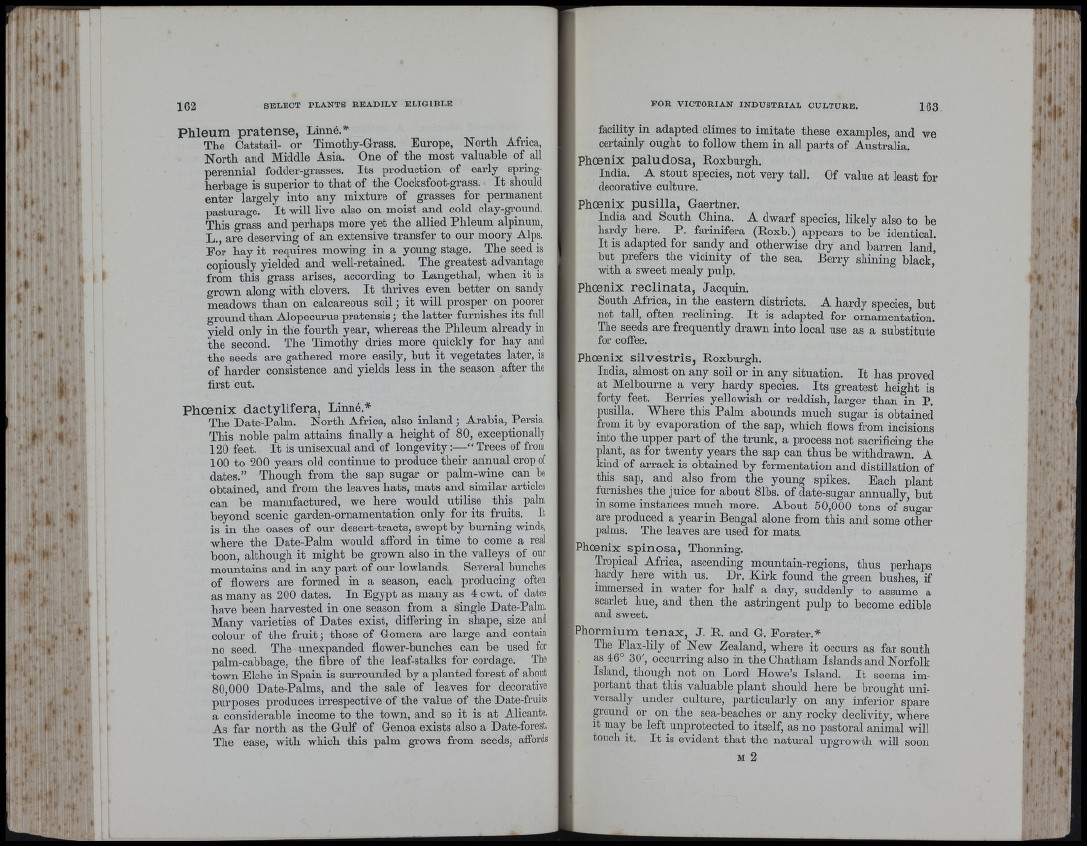
4 ri- ■ I
f '
I,.;
- t
ÜL' '’'‘rt.
i/ll '«
IL te
}
*! iic
162 SELECT PLANTS READILY ELIGIBLE
P h l e u m p r a t e n s e , Linné.* . l ai--
The Catstail- or Timothy-Grass. Europe, North Atrica,
North and Middle Asia. One of the most valuable of all
perennial fodder-grasses. Its production of early spring-
herbage is superior to that of the Cocksfoot-grass. I t should
enter largely into any mixture of grasses for permanent
pasturage. I t will live also on moist and cold clay-ground.
This grass and perhaps more yet the allied Phleum alpinuin,
L., are deserving of an extensive transfer to our moory Alps.
Eor hay it requires mowing in a young stage. The seed is
copiously yielded and well-retained. The greatest advantage
from this grass arises, according to Langethal, when it is
grown along with clovers. I t thrives even better on sandy
meadows than on calcareous soil ; it will prosper on poorer
»round than Alopecurus pratensis ; the latter furnishes its full
yield only in the fourth year, whereas the Phleum already in
the second. The Timothy dries more quickly for hay and
the seeds are gathered more easily, but it vegetates later, is
of harder consistence and yields less in the season after the
first cut.
Phoenix dactylifera, Linné.*
The Date-Palm. North Africa, also inland ; Arabia, Persia.
This noble palm attains finally a height of 80, exceptionally
120 feet. I t is unisexual and of longevity :—“ Trees of from
1 0 0 to 2 0 0 years old continue to produce tbeir annual crop of
dates.” Though from the sap sugar or palm-wine can he
obtained, and from the leaves hats, mats and similar articles
can be manufactured, we here would utilise this palm
beyond scenic garden-ornamentation only for its fruits. It
is in the oases of our desert-tracts, swept by burning winds,
where the Date-Palm would afibrd in time to come a real
boon, altbongb it might be grown also in the valleys of oim
mountains and in any part of our lowlands. Several bunches
of flowers are formed in a season, each producing often
as many as 200 dates. In Egypt as many as 4 cwt. of dates
have been harvested in one season from a single Date-Palm.
Many varieties of Dates exist, difiering in shape, size and
colour of the fruit ; those of Gomera are large and contain
no seed. The unexpanded flower-bunches can be used for
palm-cabbage, the fibre of the leaf-stalks for cordage. The
town Elche in Spain is surrounded by a planted forest of about
80,000 Date-Palms, and the sale of leaves for decorative
purposes produces irrespective of the value of the Date-fruits
a considerable income to the town, and so it is at Alicante.
As far north as the Gulf of Genoa exists also a Date-forest.
The ease, with which this palm grows from seeds, afibrds
FOR VICTORIAN INDUSTRIAL CULTURE. 163
facility in adapted climes to imitate these examples, and we
certainly ought to follow them in all parts of Australia.
Phoenix paludosa, Roxburgh.
India. ^ A stout species, not very tall. Of value at least for
decorative culture.
Phoenix pusilla, Gaertner.
India and South China. A dwarf species, likely also to be
hardy here. P. farinifera (Roxb.) appears to be identical.
It is adapted for sandy and otherwise dry and barren land,
but prefers the vicinity of the sea. Berry shining black,’
with a sweet mealy pulp. ’
Phoenix reclinata, Jacquin.
South Africa, in the eastern districts. A hardy species but
not tall, often reclining. I t is adapted for ornamentation.
The seeds are frequently drawn into local use as a substitute
for coffee.
Phoenix silvestris, Roxburgh.
India, almost on any soil or in any situation. I t has proved
at Melbourne a very hardy species. Its greatest height is
forty feet. Berries yellowish or reddish, larger than in P.
pusilla. lYhere this Palm abounds much sugar is obtained
from it by evaporation of the sap, which flows from incisions
into the upper part of the trunk, a process not sacrificing the
plant, as for twenty years the sap can thus be withdrawn. A
kind of arrack is obtained by fermentation and distillation of
this sap, and also from the young spikes. Each plant
furnishes the juice for about 81bs. of date-sugar annually, but
in some instances much more. About 50,000 tons of su»ar
are produced a year in Bengal alone from this and some other
palms. The leaves are used for mats.
Phoenix spinosa, Thoiming.
Tropical Africa, ascending mountain-regions, thus perhaps
hardy here with us. Dr. Kirk found the green bushes, if
immersed in water for half a day, suddenly to assume a
scarlet hue, and then the astringent pulp to become edible
and sweet.
Phormium tenax, J. R. and G. Eorster.*
The Flax-lily of New Zealand, where it occurs as far south
as 46° 30', occurring also in the Chatham Islands and Norfolk
Island, though not on Lord Howe’s Island. I t seems important
that this valuable plant should here be brought universally
under culture, particularly on any inferior spare
ground or on the sea-beaches or any rocky declivity, where
it may be left unprotected to itself, as no pastoral animal will
touch it. I t is evident that the natural upgrowth will soon
M 2
! i . I'
'I
|i
fqr
r t
i
•r t
I
: I
I